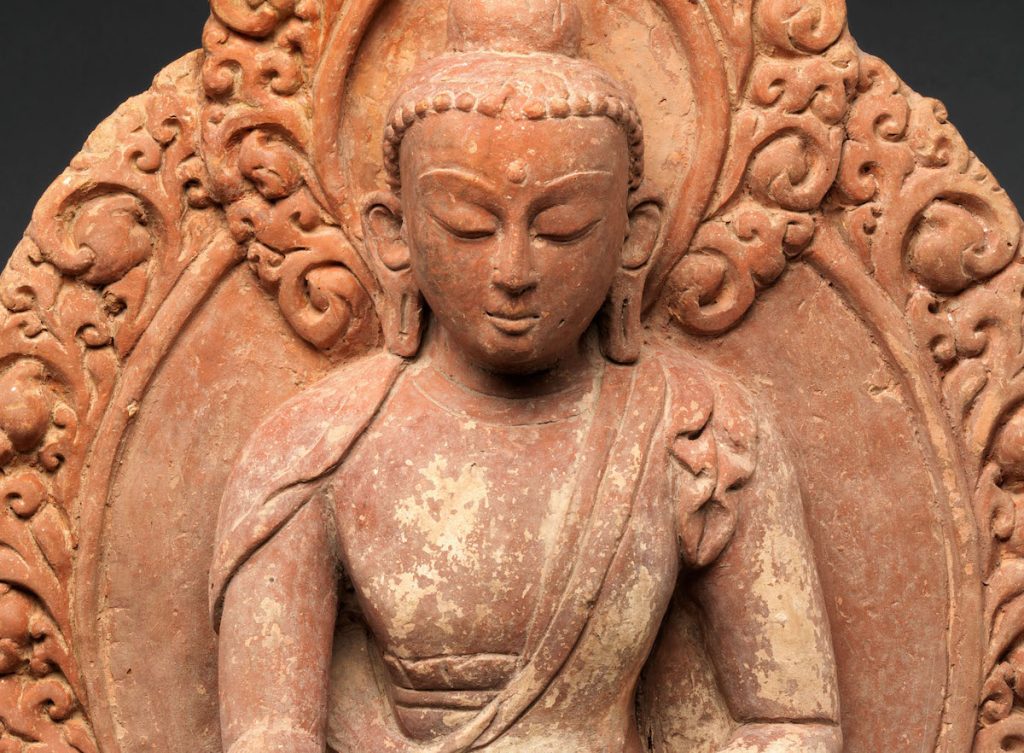Visit any yoga studio, wellness center, or trendy home decor store, and you’re bound to find a decorative Buddha seated in a cross-legged lotus posture, his gaze downcast in meditative concentration. Although this Buddha is the token accessory of today’s mindfulness culture, he hasn’t always been depicted this way.
In early Buddhist art, the historical Buddha was rarely shown in human form—instead, his presence was conveyed by a blooming lotus, a pair of footprints, a spoked wheel, or a perched deer in stone relief. The reason? North Indian Buddhist communities feared that if they represented the Buddha as a man, people would start worshipping him like a god.
But as Buddhism spread beyond India along medieval trade routes and came into contact with neighboring cultures, embodied images of the Buddha became the norm. The tradition’s art, iconography, and ideology continued to evolve over the following centuries, giving rise to the diverse pantheon of deities we see today.
“Cosmic Buddhas in the Himalayas,” an exhibition at the Metropolitan Museum of Art in New York City, tells the story of how Buddhism’s five Tathagatas—celestial Buddhas who preside over the four heavens—came to be. Each of these awakened beings personifies qualities such as compassion, abundance, health, and protection, and charts out a direct course to enlightenment for devotees.
The exhibition is on view through December 10, 2017, and invites viewers to explore the complex world of Himalayan Buddhist belief through sculptures and paintings from the 13th through 19th centuries in what is now Nepal and Tibet.
Associate curator, art historian, and author Kurt Behrendt spoke with Tricycle about how he turned the Met’s gallery into a metaphor for the Buddhist cosmos and explains how ritual art can be a gateway to spiritual awakening.
Related: Himalayan Buddhist Art 101: The Buddha
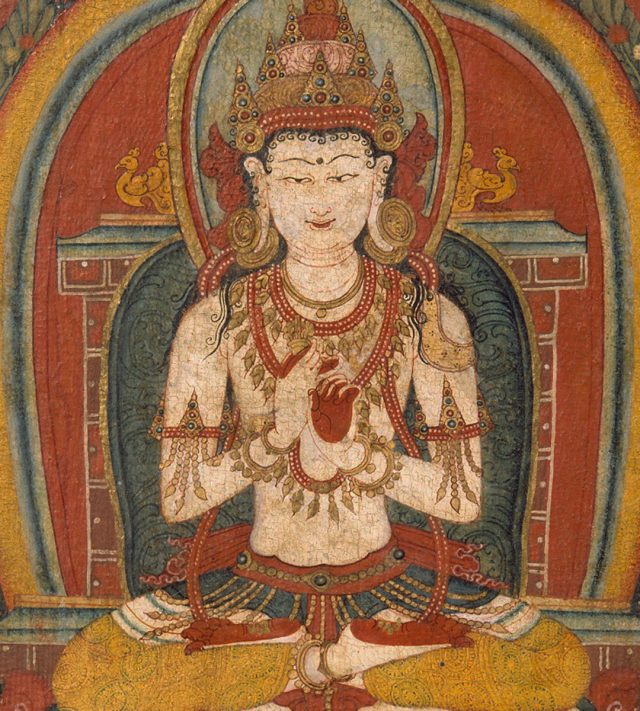
How does the pantheon of deities depicted in Himalayan art harken back to the historical Buddha?
The Buddha Shakyamuni was a human being, just like you or me, who broke free from the endless cycle of rebirth, or samsara, through persistent trial and error. According to the Yoga Tantra, a popular Vajrayana text, at the moment of his enlightenment, the Buddha left his physical body and ascended to the highest heaven atop Mount Meru, where he assumed the perfected, crowned, and bejeweled form of Vairochana. He then returned to the bodhi tree in our realm of existence, and in his physical body went out into the world to teach the dharma, or path to awakening, to others.
After his death, the Buddha was given a burial fit for a king—his physical body was cremated, and his ashes, the physical “stuff” of enlightenment, were all that was left. His relics were enshrined in votive reliquaries, or stupas, that became emblematic of both the dharma and of the Buddha himself. Today, relics are still a devotional focus at sacred Buddhist sites across South Asia.
These relics give us access to the historic Buddha’s physical body in our world, while at the same time, Vairochana (his mind-made body, or manomayakaya) continues to exist in a heaven at the cosmic axis of the universe. Light streams out from Vairochana, which brings the cosmic Buddhas into being. Ultimately, we can understand Shakyamuni’s enlightenment as giving form to the five Tathagata Buddhas.
Related: Tantric Art: Maps of Enlightenment
Who are the five cosmic Buddhas, and what do they reveal about the Mahayana and Vajrayana worldview?
Presiding over the four heavens, or Pure Lands, are the five Tathagata Buddhas. Vairochana dwells at the center of the heavens, and you can find the other four Buddhas—Amitabha, Amoghasiddhi, Akshobhya, and Ratnasambhava—in each of the cardinal directions. For pious devotees, the most important of these deities is Amitabha. Worshippers hope to be reborn in Amitabha’s Western Pure Land so they can gain direct access to his teachings, which offer an immediate way to break free from samsara. [This aspiration] remains a central goal for lay and monastic practitioners.
Each of the celestial Buddhas are understood to emanate various subsidiary deities that are keystones in Himalayan Buddhism. One great example is Avalokiteshvara, the bodhisattva of infinite compassion, who presides over our realm of existence: the period after the Buddha Shakyamuni’s death and before the coming of the future Buddha Maitreya. Avalokiteshvara emanated from Amitabha when a ray of light emitted from his urna [forehead mark or third eye] while he was sitting in meditation. After attaining enlightenment, Avalokiteshvara chose to liberate all sentient beings from suffering before entering nirvana. Avalokiteshvara remains a fundamental bodhisattva today—the Dalai Lama, in fact, is recognized by the Gelugpa school of Tibetan Buddhism as the living incarnation of Avalokiteshvara.
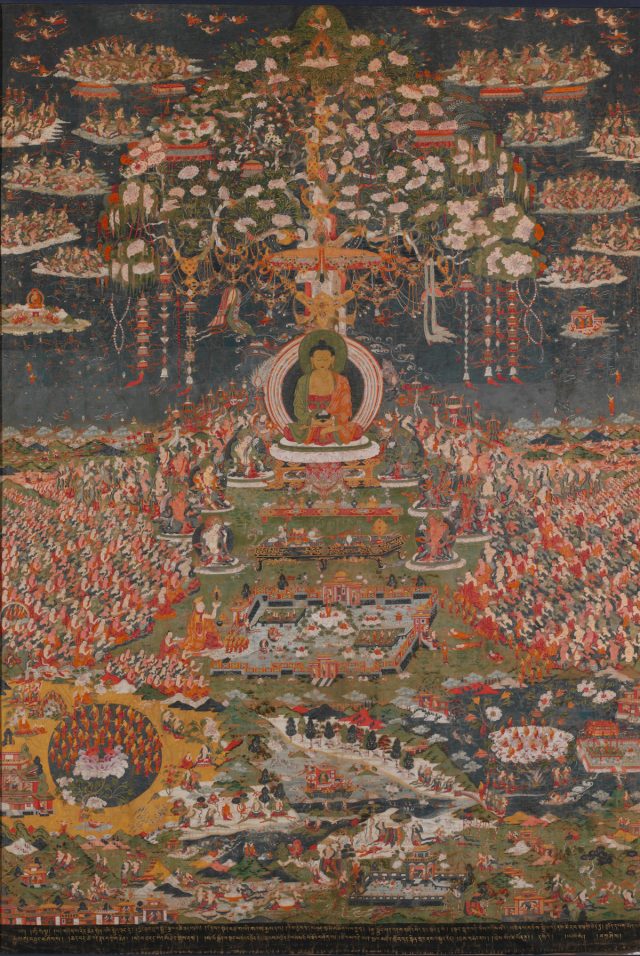
You’ve arranged the Met gallery space in a way that mirrors Buddhist cosmology. Tell me about the atmosphere you’ve created and why viewers may want to keep it in mind while making their way through the exhibit.
This exhibition places the Buddha Vairochana at the center of the room, and on the walls you’ll find the Buddhas that preside over the four heavens in the north, south, east, and west: Amoghasiddhi, Ratnasambhava, Akshobhya, and Amitabha, respectively. Grouped on each of the four walls are many of their manifestations that make up the Himalayan Buddhist pantheon. The artwork reflects what people actually did in terms of practice and where their beliefs were grounded. For the devout, depictions of the divinities aided meditation and devotional practice. Venerating these five Buddhas offered practitioners a direct path to enlightenment.
Out of the 18 works on display, walk me through some highlights—what are the must-sees?
I’d begin with the 14th-century Vajradhatu (Diamond Realm) Mandala, an exquisite diagram of the heavens that features Vairochana at its center, framed by the four directional cosmic Buddhas residing in their distinctive, color-coded realms. Of course, the whole exhibition is organized to echo this mandalic conception of the heavens.
Related: Avalokiteshvara in Tibet
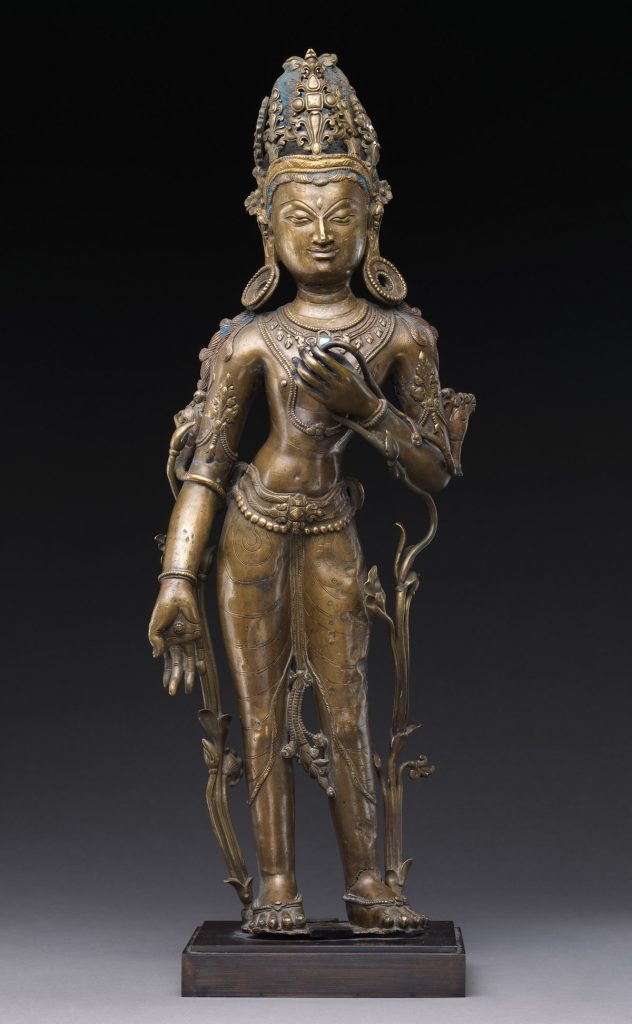
Nearby, you can find a beautifully preserved thangka [traditional Tibetan painting] of Ratnasambhava, the Buddha of the Southern Pure Land, created in the late 11th century during a time when artists were moving freely between Tibet and India. Ratnasabhava, which means “jewel-born,” has much more practical meaning for the average devotee—he is associated with material abundance and enriching worshippers with the knowledge of Buddhist teachings. Just a few generations later in the 13th century, Amoghasiddhi, who presides over the Northern Pure Land, was painted on a lotus throne in a distinctly Tibetan style. Amoghasiddhi is understood to be essentially equivalent to the historic Buddha Shakyamuni—they even share the same hand gesture of protection (abhayamudra). Being able to see these two masterpieces from the early Tibetan tradition side-by-side is definitely a highlight of the museum’s collection.
Finally, I would spend some time with the 16th- to 17th-century Nepalese terracotta sculpture of Akshobhya, who is known to have mirror-like wisdom that allows him to see reality without distortion. Not too far off, Hevajra, one of Akshobhya’s most powerful and important emanations, can be seen dancing with his consort in a 15th-century Tibetan mandala. Hevajra’s name is actually composed of two syllables: he (compassion, the male aspect) and vajra (wisdom or shunyata, the female aspect). Together, wisdom and compassion allow us to cut through the illusory world.
Related: The Western Pure Land
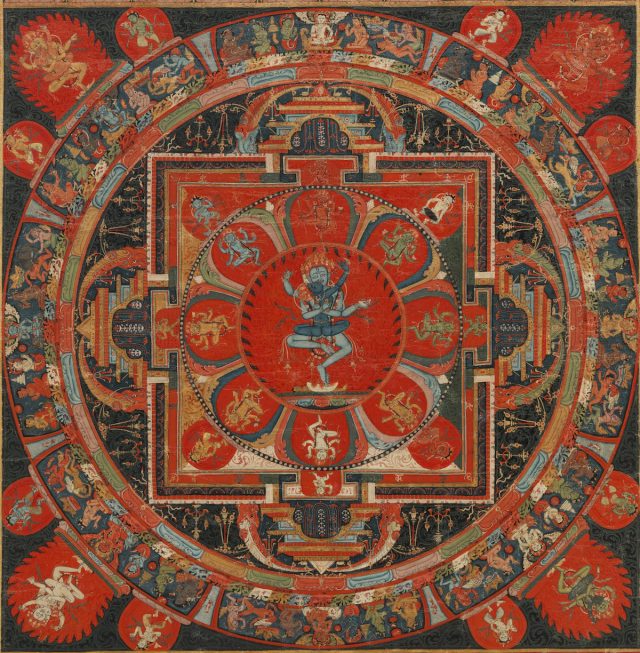
Even if we don’t use works of art for spiritual purposes, can these deities still enrich our understanding of core Buddhist concepts?
Certainly. I’ve always been struck by how ideas of enlightenment are so effectively conveyed by representations of the Buddha. The throng of Buddhist deities we see today may seem overly complex or sophisticated, but nearly all of them relate to the five celestial Buddhas. You don’t need to be a monk well-versed in tantric Buddhist practice for these pieces to move you. Think of it this way: the entire essence of enlightenment can be found in just one of these timeless sublime images.
Cosmic Buddhas in the Himalayas will be on view in the South Asian Exhibition Gallery at the Metropolitan Museum of Art through December 10, 2017. Recordings of Kurt Behrendt’s lecture series can be found here.
Thank you for subscribing to Tricycle! As a nonprofit, we depend on readers like you to keep Buddhist teachings and practices widely available.
